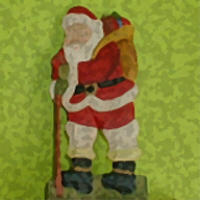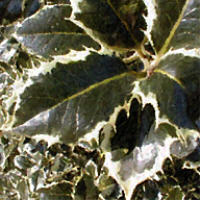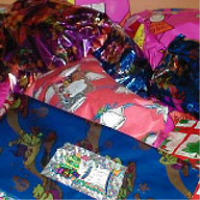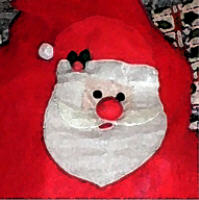|
Saint Nicholas, Santa Claus and the CHRIST Child
|
Saint Nicholas was born in about the year AD280, in Patara, on the South coast of modern-day Turkey. The ancient
city now lies in ruins. Nicholas was brought up as a Christian in a pagan world.
His homeland was under the control of Diocletian (285-305), the Roman emperor who ruled the Mediterranean region.
Anti-Christian edicts made it a dangerous time for Christians and so Nicholas’ faith like many others went
underground (like the Christians in Rome who met in the catacombs). Many believers in Asia Minor were martyred
for their faith by the Roman society, which thrived on violence, sacrifice and gladiatorial sports.
As a young boy Nicholas became an orphan, his parents died of a plague. A substantial inheritance was left and
therefore Nicholas had prominence within the society in which he lived and was more able to do good deeds, with
means at his disposal.
|
|

|
|
Three Bags of Gold
According to legend, the young man Nicholas heard of the plight of a poor father who had three daughters, but not
enough money for a dowry for any of them and was considering selling them into prostitution. Over the next two
nights, Nicholas threw a bag of gold into their window, one of which apparently landed in one of the girls' stockings,
which were hung up to dry. On the third night, the girl’s father lay in wait for the generous mysterious donor
and as Nicholas threw the third bag of gold into the window, the father ran after him and was able to thank
him. This act of kindness sowed the seed of the tradition of giving gifts. Ironically pawn-brokers used the
symbol of the three bags of gold (or three golden balls to represent the bags) as their identifying symbol.
The Traditions
Sometime in Nicholas' life he moved to Myra, an ancient Roman city, where he spent most of his adult life and from
where much of his legend springs. Today the city in Turkey lies in ruins and bears witness to the vibrant
Christian community that he once led.
One tradition says that St. Nicholas was aboard a ship when a violent storm began to blow; passengers and crew
were terrified and feared for their lives. St. Nicholas told them to pray and the water became calm and from then
on he became the patron saint of seafarers.
St. Nicholas is also known as the protector of victims of injustice - three Christians were unduly judged and were
before the executioner when St. Nicholas rushed to the executioner’s platform and saved their lives.
Christianity Legalised
In time, the Roman Empire fell into turmoil and began to crumble, eventually breaking up into East and
West after a decisive battle. In 312 Constantine became the Caesar and Emperor (312-337) of the West, after winning
the victory at Milvien Bridge, in Rome, Italy. Here he prayed to the Supreme God for help and he saw a sign: a cross
in the noon-day sky above the sun and with it the words, ‘Conquer by this.’
That night Christ appeared to him and commanded him to go into battle in the name of Christ. The next day the battle
commenced against Maxentius, who was induced to fight outside the City fortification. Constantine won the battle and
converted to Christianity. The persecution of Christians was called off and Constantine used the church to help
govern the people of the empire. In 313, the Edict of Milan proclaimed toleration for both Christianity and
pagan religions and in 321, Constantine made the first day of the week a holiday (Sunday).
|
|

|
|
St. Nicholas’ Character
In 313, Nicholas became the Bishop of Myra and therefore had great power, prestige, authority and influence over the
community at large. For the first time in his life Nicholas was able to worship openly. There are no records of his
years as a Bishop apart from tradition, but it appears that he was revered as a kindly fellow who helped the poor
and sick, but also one who had a feisty ‘righteous’ temper.
In 325, Emperor Constantine held a council of Bishops in Nicaea; it was the first ‘ecumenical’ (general) council.
Arius and only one other Bishop disagreed with the general consent that Jesus was ‘of one essence’ with the Father.
Nicholas was so incensed with the heretical view of Arius, so legend has it, that he slapped him round the face!
|
|
Death and Burial
Nicholas died around 340 on 6th December and was laid to rest in the church where he preached in the town of Myra.
In 325, Helena the mother of Constantine searched the Holy Land for religious relics and she apparently found Golgotha,
where Jesus was crucified, the cross Jesus was crucified on and the spear that pierced His side. The Church of the Holy
Sepulchre was built over the spot and so the relic industry began.
Pilgrims Pay their Respect
Stories about the miracles performed by the beloved local Bishop were told and retold and by the 6th century, an
enlarged church was built, named the Basilica of Saint Nicholas. By that time, he was known as St. Nicholas of
Myra. As more pilgrims arrived in Myra, to visit the bones of St. Nicholas his posthumous fame spread. On one
occasion a priest announced that a miracle had happened - the bones of St. Nicholas had exuded a perfumed
liquid, which they called ‘Manna Water.’ Even more pilgrims travelled to the basilica to pray for his protection
and blessing on route to the Holy Land. For a very good donation, a pilgrim could purchase some of the Manna
Water, which was a prized possession.
Theft of St. Nicholas' Bones
An influential biography of St. Nicholas appeared in the 9th century, enhancing the Saint’s reputation. Many of the
stories described miracles such as the replenishment of wheat during a famine and even raising people from the dead.
An Italian port, Bari (on the Eastern coast near the ankle of the boot-shaped Italy) had fallen on hard times and
the merchants of the city persuaded some sailors to steal St. Nicholas' bones, which would then be housed in a
special church. Pilgrims would be attracted to the area, thus generating revenue for the citizens of Bari.
A Benedictine monk recorded the following story a few days after the event. In 1087, Italian sailors sailed across
the Mediterranean Sea and landed in Myra, and using a large mallet smashed the top of St. Nicholas' marble tomb.
The sailor was stunned by the fragrance as he collected the bones. The merchants of Bari built a special church
in 1089, to house the saint’s relics and the names of the sailors who helped in the theft were engraved on the
outside wall. Pope Urban II came to Bari to lay the bones in the crypt of the church. The church had an
agreement with the sailors that each was to receive a percentage of the pilgrim’s offerings but the church
reneged on its promise.
|
| 
|
|
Gifts for the Poor
In the 12th century, some French nuns (who were inspired by the legend of the poor father, with the three daughters and
the three bags of gold) filled stockings with fruit and nuts and left them at the houses of the poor and this custom
soon spread.
By the 15th and 16th century, the worship of Saints’ relics resulted in widespread abuse, where pilgrims were told, ‘The more
you see, the better chance you have of getting to heaven,’ or ‘The less time spent in purgatory.’ This abuse was
condemned by the Reformation leaders (started in 1517 in Germany and 1534 in England) who sought to bring an end
to this superstition.
|
|
25th December
European children believed that on the 6th December, St. Nicholas gave presents. The church, (especially the German
Protestant reformers) feared his popularity could confuse children between him and Jesus. So they discouraged this
tradition and instead introduced the ‘Christkringle’ who brought presents (not on the 6th of December) but on the
25th December, in English the Christkringle is translated as Kris Kringle.
On the 6th December, festivities were held to remember the death of St. Nicholas. They were eventually outlawed, so
the pilgrims decided to use the 25th December to remember St. Nicholas on that day, as well as the birth of Jesus
Christ. Small figurines were made of St Nicholas, which came in a multitude of designs to which the Catholic Church
goers would pray.
The New World
Of all the Protestant countries in Europe, only the Netherlands continued to revere St. Nicholas, whose name they pronounced
‘Sinterklaas,’ however he is still the patron saint of sailors and of Russia. In 1626, a group of Dutch settler’s journeyed
to the New World in a ship adorned with a figurehead of St. Nicholas. It wasn’t long before the legend of Sinterklass pronounced
‘Santa Claus’ in English took root in the New World, modern-day America.
St. Nicholas’ Bones
In 1953, the bones of St. Nicholas were removed and examined as the crypt needed repairs, this was the only time the
crypt had been opened since 1089, but every year Manna Water is still extracted from the tomb in a special church
ceremony. The tomb lies below sea level and experts believe the fluid to be humidity.
In 2003, a forensic pathologist from the town of Bari, examined the data collected from the 1953 Papal report of
St. Nicholas' remains. Many of the bones were missing, to include part of the left jawbone.
Over eighty years ago a box containing five pieces of bone with the inscription St Nicholas (on a picture of the saint)
were found in the ruins of a church in the old city of Antaliya, Turkey, and went on display in the Antaliya Museum. The
forensic pathologist alongside another expert examined the bones and compared them to the Papal report and concluded
that the jawbone was not part of St. Nicholas’ remains as it was from the wrong side.
Even today in the 21st century the citizens of Bari annually celebrate the ‘liberation’ of St. Nicholas bones from
Myra and St. Nicholas has evolved into Santa Claus, the giver of gifts.
Father Christmas and Christmas Banned!
In 1646, Josiah King wrote the first reference of Father Christmas in the English language in a pamphlet. It was called:
‘The Examination and Tyrall of Old Father Christmas, Together with his Clearing by the Jury, at the Assizes held at the Town
of Difference.’ It is unclear whether Father Christmas and Santa Claus in the 1640s are the one and the same because Father
Christmas in fifteenth century England was known as Sir Christmas, but he was not associated with present giving. It was not
until the nineteenth century that Father Christmas and Santa Claus became one and the same.
In 1647, after the Civil War (1642-1645) in Britain and before the Republican Government (1649-1660) under Oliver Cromwell,
the Lord Protector, the English Parliament abolished the celebration of Christmas. They described it as: ‘A popish festival
with no biblical justification.’ Before this, Christmas celebrations often lasted from five to twelve days and for many included much
debauchery and drunkenness.
Twelve years later, in 1659 the Puritans of Massachusetts (in America) imposed a fine of 5 shillings (a large amount of money)
for any person celebrating Christmas. The law (as in England) did not specifically mention the giving of presents or Santa Claus,
but are likely to be considered part of a ‘celebration.’
In 1660, following restoration of the British monarchy, the ban on Christmas celebrations are reprieved. Old traditions were revived;
The 12 Days of Christmas is a period of entertainment that end on the Twelfth Night (5/6 January), the feast of Epiphany (the manifestation
of Christ to the Gentiles as represented by the Magi (Matthew 2:1-12).
New York 1800s
Santa Claus, or as he is known in Britain, Father Christmas, has been shaped by many cultures into what he is today. In
the 1800s in New York, the old European tradition was still alive, where the poor visited the wealthy to eat and drink
and could demand a gift during the festive season. With the flux of immigrants into New York, the upper classes got a
little annoyed with this ‘give on demand’ culture which they felt obliged to participate in, but decided to do
something about. They encouraged the working classes to wait at home to receive a gift (which was far better than
to come looking for it), as this is what the poor father of three daughters did who considered selling them into
prostitution; along came St. Nicholas who threw three bags of gold through their window thus saving the daughters.
|
| 
|
|
Turkey’s for the Poor
On the afternoon of Christmas Eve 1822, Clement Clark Moore, of New York, got on his sleigh to deliver some turkeys
to poorer families in the area. The thought ran through his mind, which birthed the poem ‘A Visit from St. Nicholas’
(‘Twas the night before Christmas...’) and the following year it was published. This poem was the first time that a
written description of Santa Claus was published and it became a huge hit; but no illustrations were given. It spoke
of Santa Claus, who was dressed in fur, tarnished with ashes and soot with a bundle of toys flung over his back. He was
coming uninvited into a house at the still of night, where stockings were hung up, as the occupants anticipated the
arrival of St. Nicholas.
|
|
The First Illustration
In 1848, the book ‘A Visit from St. Nicholas’ by Henry Underdunk was published, which gave the first ever illustrations
of Santa Claus. Mr Underdunk had commissioned the wood graver Theodore Boyd, who is believed to have modelled Santa
Claus on a Dutch handyman; the picture has a strong Dutch influence. But the illustrations of Santa Claus are not what
we know of him today, though there are similarities. Santa Claus was illustrated as a tiny elf figure, with human
features. He drove a miniature sleigh with miniature reindeer.
In the 1860s, Santa Claus appeared in ‘Harper Weekly’, which was one of the largest American magazines in circulation.
The artist and cartoonist, Thomas Nast evolved the figure into what we know today as Santa Claus. Mr Nast tried not to
deviate from what had already been perceived of this mythical character; Santa was short and stubby but of a human size,
he had rosy cheeks, a warm inner glow and smoked a long pipe.
As the American Civil war was being fought (1861-1865), Santa was illustrated as giving presents of bayonets, military belts, guns
for the boys and dolls for the girls. In one illustration he wore a coat bearing the stars and stripes and was
visiting the troops to help boost moral. Mr Nast also gave Santa a workshop, a home at the North Pole, the legendary
ledger book in which the names of those who had been good or bad had been placed and a large lap for children to sit
on. As Santa had now grown to human proportions many children were concerned how he would fit down the chimney to
deliver their presents; even in the 21st century this still baffles people!
Santa the Money Maker
In 1890, James Edgar, an American merchant dressed up in various uniforms and outfits in an attempt to attract people
into his shop, all failed but one – Santa Claus and from that the Santa craze was birthed.
In 1896, the ‘Volunteers of America’ sidewalk Santa was founded, to collect money for charity and to perform Santa’s
charitable deeds. In America in the 21st century, tens of thousands of people are still involved, bringing a smile to many
a sad face.
|
| 
|
|
Is there a Santa Claus?
In 1897, eight-year-old Virginia O’Hanlon wrote to the New York Sun newspaper and asked the question: 'Is there a Santa
Claus?' She went on to say that she believed there was, but some of her younger friends said that there was not; her
dad said that if you see it in the Sun then you will know for sure. The editor Francis Church personally replied to the
letter: ‘…Yes Virginia there is a Santa Claus. He exists as certainly as love and generosity and devotion exists…’ In
1974, the cartoon ‘Yes Virginia there is a Santa Claus’ was screened detailing this historic event.
|
|
Star of the Movies and Adverts
In 1903, the first film of Santa Claus was made and released; it was called ‘A Fantasy actually filmed in Northern
Alaska’ by Mr and Mrs F.E. Kleinschmidt. The Santa was odd looking, even scary, but was arrayed with all his trappings,
of beard and sleigh. I am pretty sure that he wore a red coat with white fur, but the film was naturally in black and white!
In the 1920s, Santa became the salesman’s ploy. Illustrator Haden Sungloom used Santa as the hardest working person on
the planet, who after delivering millions of presents across the globe, needed a well deserved break and the Coke-Cola
advert ‘Thanks for the pause that refreshes’ was birthed. Santa was dressed in his bright red suit with white fur
trimming. After that Santa sold and still sells: drinks, sweets, fruit, soaps, comics, shavers, stamps, gift tape
and even cars etc.
In 1927, a radio programme in Finland pinpoints Santa’s home on Lapland’s Korvatunturi or ‘Ear Mountain.’ The top of the
mountain resembles rabbit’s ears which are identified as the devices that enable Santa to listen in on all the children of the
world wishes, and to hear whether they have been good or naughty.
Rudolf the Reindeer
In 1939, the American department store ‘Montgomery Ward’ commissioned the book ‘Rudolph the Red-Nosed Reindeer’ to give
away as a promotional to its customers and out of this Rudolph was born. In 1975, Rudolf got his own television special
in ‘Rudolph’s Shiny New Year.’
Letter for Santa
In 1947, the original ‘Miracle on the 34th Street’ film was released. Kris Kringle played by Edmon Gwen, won an Oscar
as the best supporting actor. In one scene, bags of children’s letters written to Santa were dragged into the courtroom
in Kris Kringle’s defence. After this film, children from New York started writing to Santa and the craze spread.
Eventually the U.S. Postal Service started ‘Operation Santa-Claus’ due to the huge volume of mail addressed to Santa,
members of the public were invited to become a secret Santa and to reply. Every year, New York alone receives over
250,000 letters posted to Santa.
In 1995, Canada Post announced that letters addressed to Santa Claus would arrive more quickly if they carry the new postcode
which has just been allocated for Santa: HOH OHO (ho, ho, ho).
Tracking Santa
In 1955, a ‘Sears’ department store in Colorado, America advertised a flier, with a 'track Santa' telephone hotline.
Accidentally they printed the telephone number of the U.S. Military, NORAD, (North America Air Defence Command) and
on Christmas Eve the security personnel were inundated with children phoning in, wanting to know “Where is Santa?”
NORAD responded by setting up ‘NORAD Santa Tracking’ so that excited children and adults could find out ‘Where is
Santa?’ If you want to know where Santa is on Christmas Eve, the 24th December, then log onto noradsanta.org
The CHRIST child and CHRISTmas
Mary of Nazareth was visited by the angel Gabriel who said, “Rejoice highly favoured one, the Lord is with you;
blessed are you among women! …You will conceive in your womb and bring forth a Son, and shall call His name JESUS. He will be great,
and will be called the Son of the Highest; and the Lord God will give Him the throne of His father David” (King David). “The Holy
Spirit will come upon you, and the power of the Highest will overshadow you, therefore, also, that Holy One who is to be born will
be called the Son of God” (Luke 1:26-35).
Joseph who was betrothed to Mary was visited by an angel of the Lord in a dream. The angel stated, “That which is
conceived of her is of the Holy Spirit. And she will bring forth a Son, and you shall call His name JESUS for He will
save His people from their sins.” The was in accordance to what the Lord had spoken through the prophet saying, “Behold,
a virgin shall be with child, and bear a Son, and they shall call His name Immanuel,” which is translated, “God with us”
(Matthew 1:20a-23).
Christmas Odds
In 1539, the first Christmas tree appears in Strasbourg Cathedral (modern-day Eastern France, near the German border).
In 1882, on the 22 December, Thomas Edison created the first string of Christmas tree lights.
In 1932, King George V of Great Britain initiated the Christmas Day radio broadcasts that served to link the Commonwealth countries in a common bond.
In 1957, entertainer Professor Tribini introduced the world to the first World Santa Congress which has been held every year since. It was first held at the Bakken amusement park in Denmark.
In 1985, Band-Aid’s ‘Do they know it’s Christmas?’ became the best-selling British single of all time.
In 1998, Cuba’s Communist rulers declared that Santa Claus and nativity scenes could return to the island for good, almost thirty years after Christmas was abolished as a public holiday.
On Christmas Day 2003, Britain’s Mars space craft Beagle was separated from its mother ship to land on the red planet but was never heard from again (though later found). The failed project cost £200 million!
In 2009, due to the global recession, the Finnish Government sold its 32% stake in Santapark, home to Father Christmas. The new landlords was a company called Santa's Holding Ltd.
In December 2012, the department store Debenhams announced that Father Christmas will no longer be appearing in their stores.
Other Christmas Pages:
Christmas Home Page Go
What Happened In History on the 25th December? Go
Christmas WW1 Truce, 25th December 1914 Go
How Do Other Nations Spend Christmas? Go
The Politically Correct Christmas Go
Christmas Trees in England Go
Christmas Jokes Go
|

|
|
